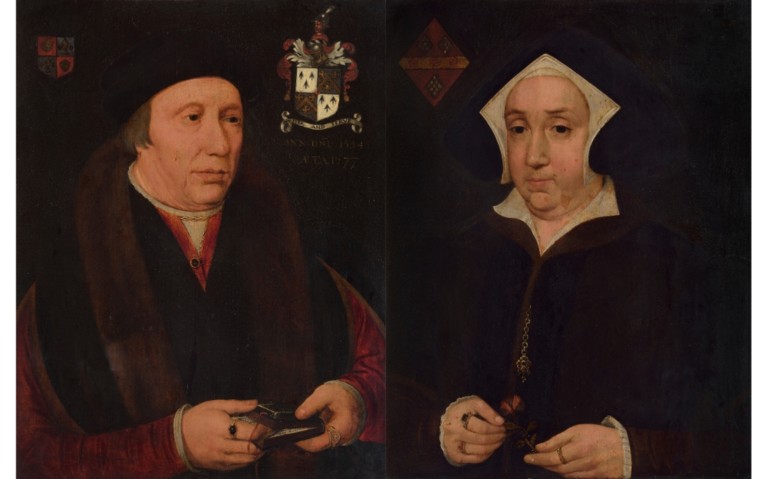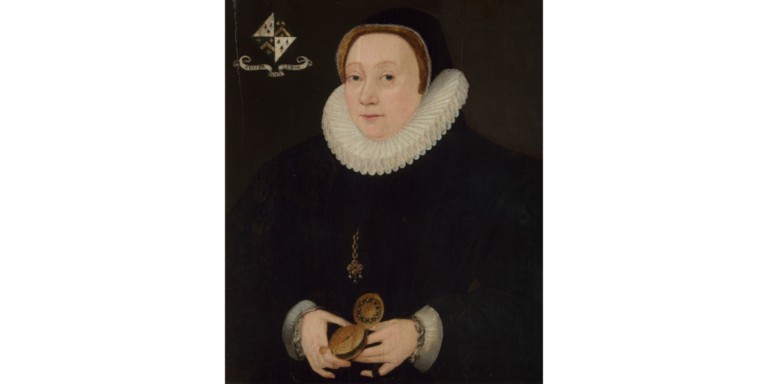Blog
9 September 2021
In the Hall at Emmanuel, hangs a portrait of one of the College’s earliest benefactors, Mrs Joyce Frankland (1531–87).
.jpg)
This wealthy Elizabethan widow is known to posterity because of the generosity by which she rose above a personal tragedy that befell her, so becoming one of the greatest educational benefactors of her time. Her portraits still hang in the Halls of the three Oxbridge colleges to which she bequeathed them.
Emmanuel’s portrait (Plate 1—A: Portrait of Joyce Frankland from Emmanuel College, Cambridge) shows her in a black gown and cap, with a wide ruff. The lozenge displaying her arms is repeated on the ring on her right hand. Her motto is ‘Suffer and serve’. Emmanuel’s portrait on canvas is copied from the panel portrait of herself that Joyce bequeathed to Gonville & Caius College, Cambridge, along with portraits of her parents, Robert Trappes and his wife Joanna (Plates 2 & 3—B: Portraits of Robert & Johanna Trappes from Brasenose College, Oxford, and Gonville & Caius College, Cambridge). In all her portraits, Joyce holds an open pocket–watch, and wears the jewelled pendant cross that her mother is shown wearing in her portrait.

Robert Trappes was a London goldsmith, and Joyce was married successively to two wealthy Londoners. In 1549, at Banstead in Surrey, she married Henry Saxey, and their son William, after studying at Cambridge, was admitted to Gray’s Inn in 1576. After Henry’s death, Joyce married William Frankland (d. 1577), who left her substantial property in Hertfordshire; there were no children of Joyce’s second marriage. But in August 1581, Joyce’s only son William ‘youthfully venturing to ride upon an unbroken young horse, was thrown down and slain’. We know what happened next from a letter to Archbishop Whitgift from Alexander Nowell, the Dean of St Paul’s: "The mother fell into sorrows uncomfortable, whereof I, being of her acquaintance, having intelligence, did with all speed ride to her house near Hoddesdon to comfort her the best I could, and I did find her crying, or rather howling continually, ‘Oh my son, my son!’"
Not for nothing is Nowell, in his fundraising initiatives, described as ‘that notable beggar’ by a recent historian. Nowell’s account continues: "And when I could by no comfortable words stay her from that cry and tearing of her hair, God, I think, put me in mind at last to say: ‘Comfort yourself, good Mrs Frankland, and I will tell you how you shall have 20 good sons to comfort you in these your sorrows which you take for this one son.’ To which words only she gave ear, and looking up asked: ‘How can that be?’ And I said unto her: ‘You are a widow, rich and now childless, and there be in both universities so many poor toward youths that lack exhibition, for whom if you would found certain fellowships and scholarships to be bestowed upon studious young men, who should be called Mrs Frankland’s scholars, they would be in love towards you as dear children…and they and their successors after them, being still Mrs Frankland’s scholars, will honour your memory for ever and ever.’ This being said, ‘I will,’ quoth she, ‘think thereupon earnestly…’"
At her death, six years later, Joyce Frankland’s will left endowments to the value of £2000 to Gonville & Caius College, Cambridge. To Brasenose College, Oxford, she bequeathed property worth £1840, together with valuable plate, and her portrait which still hangs in the Hall there (Plate 3—B: Portrait of Joyce Frankland, from Brasenose College, Oxford).
 To Emmanuel, Joyce bequeathed £440, sensibly stipulating that it be used to purchase property yielding £20 a year. And Joyce also augmented benefactions that her mother Joanna had already made to Lincoln College, Oxford. A network of connections probably explains Joyce’s choice of colleges. Her mother had been an acquaintance, and possibly a patient, of the physician Dr Caius. Alexander Nowell had been a Fellow of Brasenose, and Emmanuel’s founder, Sir Walter Mildmay, was one of the overseers of her will. Joyce also provided £470 to found a free grammar school at Newport in Essex, which survives as the Joyce Frankland Academy. It has been estimated that during her life, and by her will, Joyce donated the huge sum of £4840 to educational causes.
To Emmanuel, Joyce bequeathed £440, sensibly stipulating that it be used to purchase property yielding £20 a year. And Joyce also augmented benefactions that her mother Joanna had already made to Lincoln College, Oxford. A network of connections probably explains Joyce’s choice of colleges. Her mother had been an acquaintance, and possibly a patient, of the physician Dr Caius. Alexander Nowell had been a Fellow of Brasenose, and Emmanuel’s founder, Sir Walter Mildmay, was one of the overseers of her will. Joyce also provided £470 to found a free grammar school at Newport in Essex, which survives as the Joyce Frankland Academy. It has been estimated that during her life, and by her will, Joyce donated the huge sum of £4840 to educational causes.
The infant Emmanuel College, still in its first decade, used Mrs Frankland’s bequest to buy the Hyde Farm Estate at Mitcham and Clapham, in Surrey, for £500.10s. Sir Walter Mildmay supplemented the Frankland legacy with £60 of his own money, and the College came up with the remaining ten shillings. The Hyde Farm Estate remained farmland, until it was developed for suburban housing in the later nineteenth and early twentieth centuries, and was then sold off piecemeal to tenants, under the provisions of various leasehold reform legislation of the post–war period.
So, out of a tragic accident, and a mother’s consuming grief, generations of students have benefited from Joyce Frankland’s generosity and have been, many times over, the twenty adopted offspring that she was once promised.
Barry Windeatt, Keeper of the College Pictures
Back to All Blog Posts